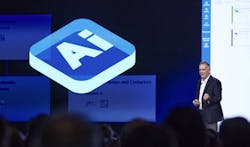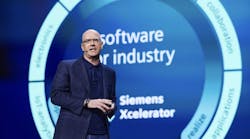Siemens Digital Industries Software annual RealizeLive event was the usual firehose of information about the company’s direction regarding cloud-based offerings, artificial intelligence (AI) implications, updates on its headset partnership with Sony and its rapid expansion into smaller and mid-sized manufacturing operations. But a key theme revolved around the company’s vision of expanding use of BOMs (bills of material) data to drive digital thread enablement up to the enterprise and supply chain levels.
To deliver this, Siemens is expanding its Xcelerator as a Service portfolio to better fulfill vertical industry requirements as well as those of individual users. According to Siemens, the goal of Xcelerator’s SaaS products is to: Connect all tasks and processes on one platform, empowering everyone throughout the value chain to work together from anywhere, simultaneously, through the use of flexible, modular solutions running on an interoperable data backbone to integrate workflows from concept to manufacturing.
The new additions to Siemens Xcelerator as a Service include:
- NX X: Product engineering software that can be installed on premises or streamed via AWS cloud services with centralized cloud license management and configuration to simplify IT requirements.
- Opcenter X: Manufacturing operations management software-as-a-service (SaaS) that provides manufacturing execution system (MES), scheduling, quality and analytics capabilities.
- Simcenter X: Delivers Simcenter simulation and test capabilities via the cloud. This initial release focuses on Simcenter Star-CCM+ computational fluid dynamics simulation software for modeling of fluid flow, heat transfer, stress, particulate flow and electromagnetics.
- Teamcenter X Essentials: Targeted at companies looking to begin their digital transformation and adopt PLM (product lifecycle management). Teamcenter X is built for mechanical CAD users, allowing them to work within their familiar CAD interface to create and manage design revisions while securely controlling, sharing and backing up their design data in the cloud. Team members without direct CAD access can use Teamcenter X Essentials to participate in the development process using 3D visualization and markup tools, engage in discussions, and manage product and service documentation.
- Zel X: A browser-based engineering app for streamlining manufacturing and shop-floor operations. Zel X consolidates software for manufacturing, operations, collaboration, design and simulation.
See all current offerings for Siemens Xcelerator.
At the RealizeLive event, Tony Hemmelgarn, president and CEO of Siemens Digital Industries Software, announced an expansion of Siemens partnership with Microsoft to make the Siemens Xcelerator as a Service portfolio of industry software available through Microsoft’s Azure cloud and AI platform, integrating it with the generative AI and Copilot features announced at least year’s RealizeLive event.
As a first step in this partnership expansion, Siemens will deliver Teamcenter X software on Microsoft Azure. According to Siemens, this collaboration builds on the launch of the Teamcenter app on Microsoft Teams which connects frontline factory and service teams to the design and engineering teams through Siemens’ Teamcenter software for PLM.
Expanding focus
First highlighted at last year’s RealizeLive event was Siemens’ broadening of its focus to include smaller to mid-sized manufacturing organizations via its Teamcenter X SaaS product. Siemens has long been viewed as a supplier of automation technologies for larger enterprises, so this expanded market focus marks a new direction for Siemens—one that became more evident at this year’s event.
Brenda Discher, senior vice president, business strategy and marketing at Siemens Digital Industries Software, explained that it took a few years for Siemens to “really think through the things outside of the product we provide that creates the experience for smaller customers. These manufacturers are not in a multi-year sales cycle, like a large enterprise. Because we were a large enterprise-oriented company, [expanding our focus] was a huge investment. But now we're there and that investment is paying off for all our customers.”
A big key to this payoff is the modularization of its software for SaaS delivery, which has enabled Siemens to create micro services in the cloud and repackage the company’s software for smaller manufacturers.
This repackaging was highlighted in a presentation by Joe Bohman, executive vice president of Siemens Digital Industries Software, where he pointed out a “good, better, best” approach to the company’s modularized software offerings.
“These ‘good’ products Joe mentioned are perfect for our smaller customers,” Discher said, because they don’t have “as much of the complexity, making them much easier to adopt.” Following this line of thought, the “better” versions of the products offer more functionality and are targeted at mid-sized manufacturers. The “best” versions are the complete versions of the products for which Siemens is known for delivering.
Bohman noted that, in addition to the new SaaS releases noted above, Capital Electra X, Insights Hub, Digital Logistics, Simcenter Cloud HPC, Polarion X, Supplyframe, Mendix, Teamcenter X Manufacturing and Additive Manufacturing Network are all available now via SaaS. Planned SaaS releases are expected to be announced soon for Solid Edge X, Capital X, Xpedition X, PADS Pro X, NX X Manufacturing and Tecnomatix X.
The SaaS approach appears to be working for Siemens in its effort to expand beyond its large enterprise base, as 84% of its new customers are considered small to medium-sized, said Discher.
But the company’s recent growth has not been all with small to mid-sized manufacturers. Larger companies are shifting to this modularized, cloud-based SaaS approach as well—including some enterprises Siemens did not expect to have interest in cloud-based software.
“The Department of Defense is recognized as being an on-prem user of software for security reasons,” said Discher. “Surprisingly, they've flipped” and are also moving to use of cloud-based SaaS to ensure use of the latest versions as well as the cloud’s recognized high level of security.
What happened to Mindsphere?
Last year Siemens began promoting Insights Hub as the evolution of Mindsphere. I took this opportunity to speak with Discher about that change and what it means for the manufacturing industries.
“When MindSphere first came out, it was positioned as a platform. What we quickly learned is that it was also a toolkit. So, our idea was to give users a platform and a toolkit to do whatever they wanted [in terms of collecting, analyzing and using IoT data],” said Discher. “Then we realized that what our customers really want are applications. They want an application to monitor a machine and they want an application to monitor operator effectiveness, for example. As we were planning to release apps that we were going to call Mindsphere for this and Mindsphere for that, we thought about what we should call the platform itself. As a company moving to a standard digital platform called Xcelerator, we didn’t want to have another platform in Mindsphere. So, we focused more on the unique capabilities we're going to deliver—which are insights about your operational effectiveness, about your productivity and the OEE (overall equipment effectiveness) for your equipment. This name change is more about the insights delivered with the software and our realization that Insights Hub should be an application with Xcelerator as the platform. To clear all that up, we decided to rebrand it.”
About the Author
David Greenfield, editor in chief
Editor in Chief

Leaders relevant to this article:


